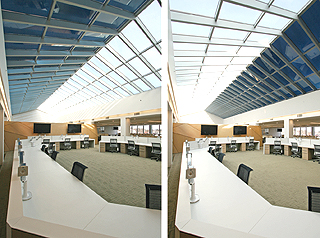|
Subscribe / Renew |
|
|
Contact Us |
|
| ► Subscribe to our Free Weekly Newsletter | |
| home | Welcome, sign in or click here to subscribe. | login |
Environment
| |
 Return to the Building Green Index Return to the Building Green Index |
February 18, 2010
Green building technologies that could change the game
Paladino and Co.

Pease
|
Green technology can help stimulate the economy, reduce carbon emissions and build a clean-energy future in the U.S. The American Economic Recovery and Reinvestment Act included almost $100 billion for investments in clean energy, energy efficiency and green job training.
With buildings accounting for 40 percent of carbon emissions in the U.S. (and 72 percent of total electricity consumption), it is expected that buildings will need to reach increasingly higher levels of performance to meet carbon reduction goals.
Part of the ARRA investment includes funding of innovation and development in areas such as controls, building envelopes and HVAC, with grants such as the U.S. Department of Energy’s $75 million Advanced Energy Efficient Building Technologies awards. Organizations like ASHRAE and the Department of Energy are mobilizing around ambitious goals such as net-zero energy use.
Green building technologies have potential to spur economic recovery and contribute to a sustainable future, but there is a distinct difference between building technologies that can change the game and ones that simply offer incremental improvements.

Image courtesy of Sage Electrochromics Windows with electrochromic glass can be tinted in minutes with the push of a button. This building in Greenwich, Conn., shows how different windows can be tinted at different times.
|
Design teams need to be able to identify the truly innovative technologies in order to recognize how and when to integrate them into a design, improve their rate of adoption and realize their full benefits.
True game-changers
Designers and even owners are inundated with technological design solutions that often represent only evolutionary or incremental building performance improvements. What makes a technology a true game changer?
Game-changing technologies reinvent the solution entirely, unlocking opportunities inherent in often abundantly available resources such as wind, heat, light or stormwater that might have previously been viewed as something to be mitigated or reduced.
Game-changing technologies should not be viewed as a one-to-one swap for a standard approach. Instead, they enable designers to harness abundant resources to serve building and occupant needs, rethink fundamental design assumptions in the interest of creating a higher-performing building than would otherwise have been possible, and often change the way occupants interact with and inhabit a building.
Following are three examples of game-changing technologies and how they can create new possibilities from abundant resources that might be considered problems when applying a standard solution.
Tinted windows
SageGlass Electrochromic Glazing, manufactured by Sage Electrochromics in Faribault, Minn., transitions from a clear to a tinted state, much like transition sunglasses work, except users can decide when and how much tinting is desired.
The product allows designers to work with sunlight and solar heat to optimize the benefits of daylighting, increased energy efficiency and reductions in HVAC size. Electrochromic glass can be operated manually or integrated into an automated building management system.
Unlike static double- or triple-pane windows with or without low-e coatings, SageGlass windows can be transformed in minutes with the push of a button, giving building occupants the ability to respond to changing weather conditions and permitting ultimate control over their space and comfort.
In the Northwest, we all know the phrase, “If you don’t like the weather, wait five minutes.” A window that responds to that familiar occurrence offers a completely new way for users to interact with the building envelope.
While initial costs are higher than standard glazing, SageGlass offers a complex value set that can provide real return on the total cost of ownership of a building. The need for expensive, high-maintenance window shading devices (both interior and exterior) is eliminated. Additionally, HVAC systems may be downsized, reducing utility costs as well as the building’s carbon footprint.
Electrochromic glazing unlocks possibilities for the design of the building itself as well. Its high efficiency and potential cost savings in other areas may allow a design team to increase the amount of glazing while improving thermal comfort, views, daylighting and glare control, all of which have been shown to increase occupant satisfaction and productivity, and enhance the overall value of the building.
Cooled by the sea
Seawater air conditioning uses nearby deep sea water to cool a building. It takes very little energy to pump cool water from a deep sea pipe inserted into ocean depths greater than 2,000 feet. The effect is much like using a drinking straw — the same effort is required to drink, no matter the depth of the glass.
This deep cold-water source is then passed through a heat exchanger, which allows the ocean water to chill a separate, closed water-circulation loop that is pumped through the building for air conditioning. The need for energy-intensive refrigeration units is eliminated and the air-conditioning system can be near net zero.
Honolulu is breaking ground this summer on a citywide seawater air-conditioning system that will cool over half the buildings downtown. Hawaii uses the most energy of any state in the U.S., so this technology offers significant opportunities for energy and cost savings.
With the high energy cost of chilling eliminated, other design possibilities are opened. A traditionally cooled building needs to be a highly insulated, tightly closed box in order to keep the cold air in the building from escaping.
However, with a source of free and plentiful cooling, insulation can be reduced and windows can even be opened. With only fan energy driving the system, controls can be put in the occupants’ hands, giving them power over their thermal comfort. They can be as cool as they like with little to no negative impacts on the environment.
Plug-and-play power
EMerge Alliance is an open industry group promoting the adoption of safe, low-voltage direct-current (DC) power distribution through ceiling grids. Doing so would create a “plug and play” platform for lights, HVAC equipment, sensors and other components, eliminating the need to convert alternating-current (AC) power for common interior fixtures.
This means device-label transformers and hard-wiring are things of the past, and spaces can be easily adapted to tenants’ needs. The elimination of transformers can also save up to 30 percent in energy lost in the conversion from AC to DC, creating opportunities for the owner to invest in better-performing components. Occupants using Wi-Fi connections can install as many sensors or controls as they want to manage the energy of their space, and take their fixtures with them when they leave.
The EMerge standard can also make it easier for an owner to use on-site renewable energy by providing a means of connection to solar, wind or other alternative energy sources, which typically generate DC power that can be tied directly into the ceiling grid without conversion back to AC.
With this fairly straightforward technology, owners can take advantage of natural resources to generate electricity, and net zero becomes much more reachable.
Emerging picture
As with any high-performance building tactic, success of these technologies in the market will depend on design teams applying the proper integrated design approach and analytics to recognize opportunities and achieve optimum performance that can be mapped back to project goals. Similarly, the impact of the industry on the economy can be mapped to goals for job and economic growth.
In a few years we should have a clear picture of how much green technologies have really changed the game.
Brad Pease is a senior green building consultant and leads the Building Science Team at Paladino and Co., a sustainability and green building consulting firm.
Other Stories:
- For a better green building, start with a simulation
- There’s more than one way to certify a green building
- Green homes outselling the rest of the market
- New product-safety tools put focus on building materials
- Tacoma housing project aims for LEED platinum
- 7 trends that will shape the future of green building
- A new use for urban high-rises: farming
- 3 steps to put homeowners on path to energy efficiency
- African Americans and sustainability: It’s all about ‘making do’
- Could poorly performing projects kill green building?


